ABS AUDI Q5 2017 Owners Manual
[x] Cancel search | Manufacturer: AUDI, Model Year: 2017, Model line: Q5, Model: AUDI Q5 2017Pages: 296, PDF Size: 74.43 MB
Page 14 of 296
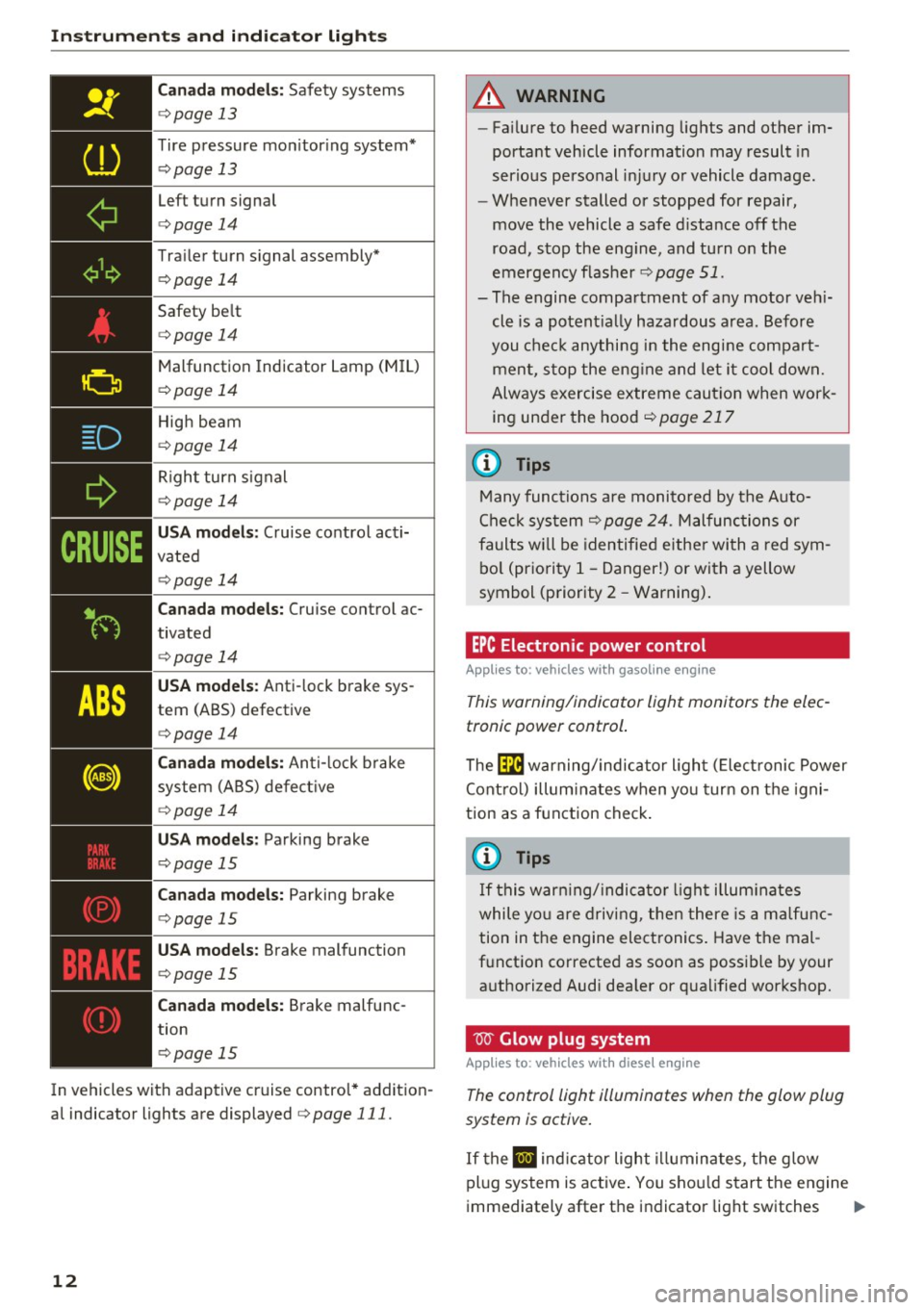
Instruments and indicator lights
Canada models: Safety systems
c:> page 13
Tire pressure mon itor ing system*
c:> page 13
Left turn signal
c:>page 14
Trailer turn s ignal assembly*
c:> page 14
Safety be lt
c:> page 14
Malfunction Indicator Lamp (M IL)
c:> page 14
High beam
c:>page 14
Right turn signal
c:> page 14
USA models: Cruise control acti
vated
c:> page 14
Can ada mode ls: Cruise control ac
tivated
c:> page 14
USA model s: Anti-lock brake sys
tem (ABS) defective
c:> page 14
Canada mode ls: Anti- lock b rake
system (ABS) defect ive
c:> page 14
USA mod els : Parking brake
c:> page 15
Can ad a mode ls: Parking brake
c:> page 15
USA models: Brake malfunction
c:> page 15
Canada mode ls: Brake malfunc
tion
c:> page 15
In vehicles with adaptive cruise control* addition
al indicator lights are displayed
c:> page 111.
12
A WARNING
-
-Fa ilure to heed warning lights and other im-
portant vehicle information may result in
serious personal inj ury or vehicle damage .
- Whenever stalled or stopped for repair,
move the vehicle a safe d istance off the
road, s top the eng ine, and turn on the
emergency flasher
c:> page 51.
- The engine compartment of any motor veh i
cle is a potent ially hazardous area. Before
you chec k anything in the engi ne compart
men t, s top the eng ine and let i t coo l down.
Always exercise extreme caut ion when wor k
ing under the hood
c:>page217
(D Tips
Many func tions are monito red by the Auto
Check sys tem
c:> page 24. Malfunc tions or
faults wi ll be identified either wi th a red sym
bo l (pr io rity 1 -Danger!) or with a yellow
symbol (priority 2 -Warning).
EPC Electronic power control
App lies to: vehicles wi th gaso line e ngi ne
This warning/indicator light monitors the elec
tronic power control .
The Ila warning/indicator ligh t (E lect ronic Power
Cont rol) illuminates when yo u turn on the igni
tion as a function check .
@ Tips
If this warn ing/ indica to r li gh t illum inates
while yo u are driving, then there is a ma lfu nc
tion in the engine electronics . Have the mal
f u nction corrected as soon as possible by your
a uthorized Audi dea ler or q ualified workshop.
W Glow plug system
App lies to : vehicles wi th diese l engin e
The control light illuminates when the glow plug
system is active.
If the II ind icator light i lluminates, the g low
pl ug system is active . You shou ld start the engine
immediately after the indicator light switches .,.
Page 15 of 296
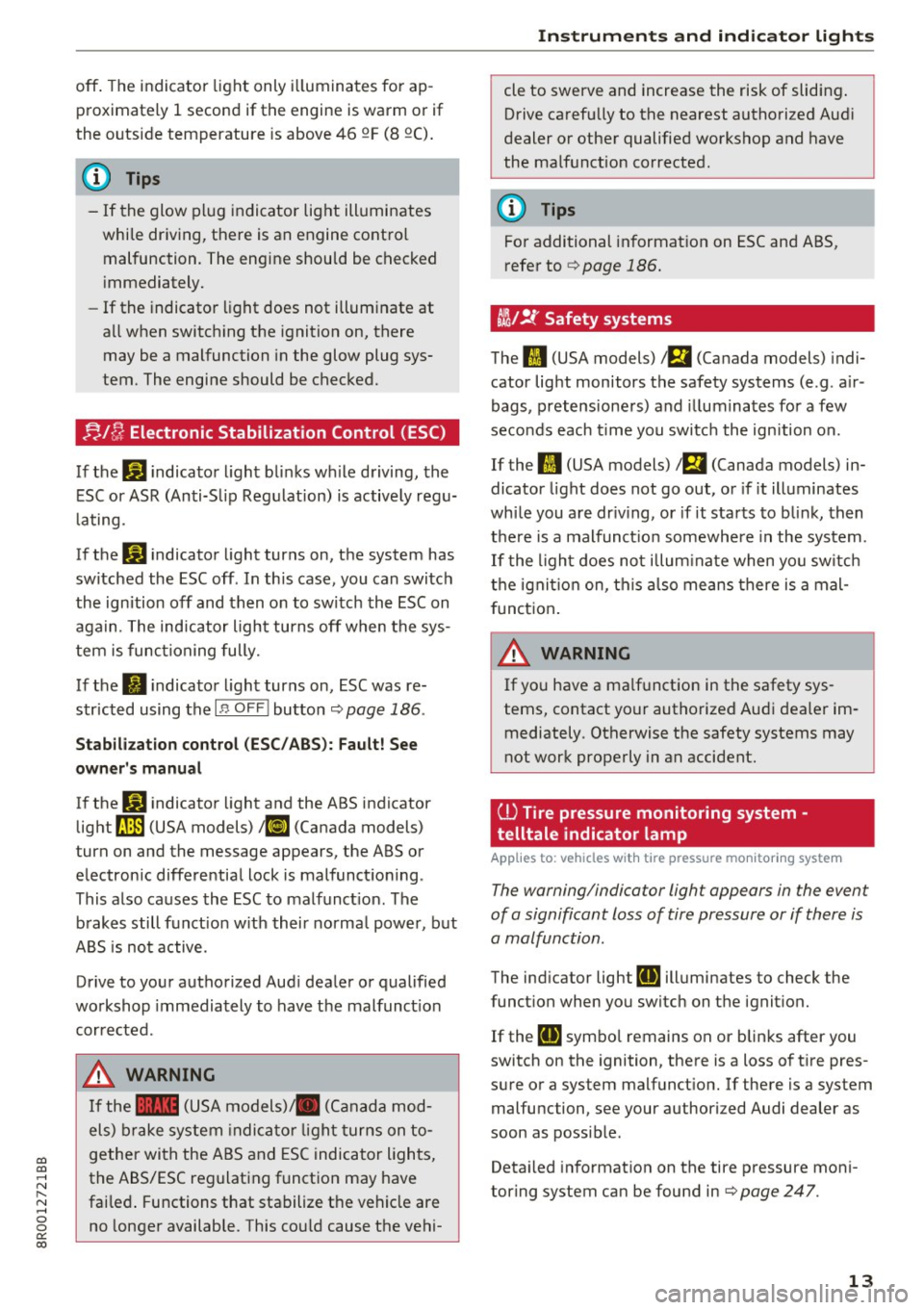
CD
CD
.... N ,-... N ..... 0 0 C<'. 00
off. Th e indicator light only illuminates for ap
proximately 1 second if the engine is warm or if
the outside temperature is above 46 QF (8 QC).
(D Tips
- If the glow plug indicator light illuminates
while driving, there is an engine control
malfunction. The engine should be checked
immediately.
- If the indicator light does not illuminate at
all when switching the ignition on, there
may be a malfunction in the glow plug sys
tem. The engine should be checked.
;J,./ fj Electronic Stabilization Control (ESC )
If the Gl indicator light blinks wh ile driving, the
ESC or ASR (Anti-Slip Regu lation) is active ly regu
lating.
If the
DJ indicator light turns on, the system has
switched the ESC off. In this case , you can switch
the ignition off and then on to switch the ESC on
again. The indicator light turns off when the sys
tem is functioning fully.
If the
II i ndicator light turns on, ESC was re
stricted using the
I " OFF ! button ¢ page 186 .
Stabilization control (ESC /ABS): Fault! See
owner 's manual
If the GI indicator light and the ABS indicator
light ~ (USA models)
1iJ (Canada models)
turn on and the message appears, the ABS or
electronic differential lock is malfunctioning .
This also causes the ESC to malfunct io n. The
brakes still funct ion w ith their normal power, but
ABS is not active.
Drive to your authorized Audi dealer or qualified
workshop immediately to have the malfunct io n
corrected.
A WARNING
If the 1111 (USA models) JII (Canada mod
els) brake system indicato r light turns on to
gether with the ABS and ESC indicator lights,
the ABS/ESC regulating function may have
fai led . Functions that stabilize the vehicle are
no longer available. This cou ld cause the vehi-
Instruments and indicator lights
cle to swerve and increase the risk of sliding.
Drive carefully to the nearest authorized Aud i
dealer or other qualified workshop and have
the malfunction corrected.
(D Tips
For additional information on ESC and ABS,
refer to ¢
page 186.
t!i/!{' Safety systems
The II (USA models) a (Canada models) indi
cator light monitors the safety systems (e.g . a ir
bags, pretensioners) and illuminates for a few
seconds each time you switc h the ignition on.
If the
II (USA models) 1 m (Canada models) in
dicator light does not go out, or if it illuminates
whi le you are dr iv ing, or if it starts to blink, then
there is a malfunct ion somewhere in the system .
If the light does not illum inate when you switch
the ignition on, this also means there is a mal
function.
A WARNING
-
If you have a ma lfunction in the safety sys
tems, contact your authorized Audi dealer im mediately . Otherwise the safety systems may
not work properly in an accident.
(l) Tire pressure monitoring system ·
telltale indicator lamp
App lies to: veh icles w it h tire pressure mo nitor ing syste m
The warning/indicator ligh t appears in the event
of a significant loss of tire pressure or if there is
a malfunction.
The indicator light [DJ illuminates to check the
function when you switch on the ignition.
If the
[DJ symbol remains on or blinks after you
switch on the ignition, there is a loss of t ire pres
sure or a system malfunction.
If there is a system
malfunction, see your authorized Audi dealer as
soon as possible.
Detai led information on the tire pressure moni
toring system can be found in ¢
page 247.
13
Page 16 of 296
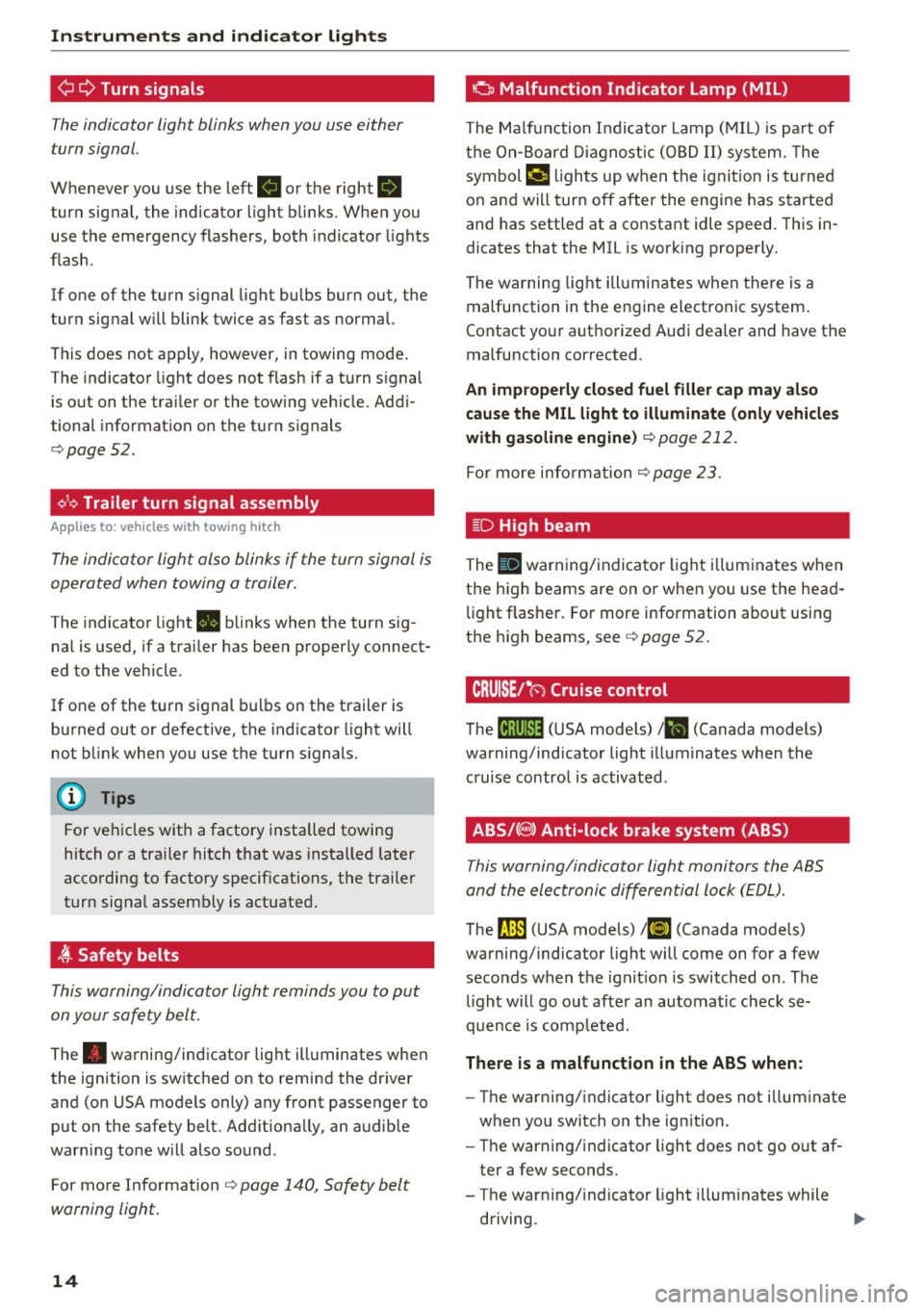
Instruments and indicator lights
¢ Q Turn signals
The indicator light blinks when you use either
turn signal.
Whenever you use the left B or the right.
turn signal, the indicator l ight blinks. When you
use the emergency flashers, both indicator lights
flash.
If one of the turn s ignal light bulbs burn out, the
turn signal w ill blink twice as fast as normal.
This does not apply, however, in towing mode .
The indicator light does not flash if a turn s ignal
is out on the tra iler or the towing vehicle. Addi
tional informat ion on the turn s ignals
c::> page52.
¢1.~ Trailer turn signal assembly
Appl ies to: ve hicles w ith towing hitch
The indicator light also blinks if the turn signal is
operated when towing a trailer .
The indicator light . blinks when the turn sig
na l is used, if a trailer has been p roperly connect
ed to the vehicle .
If one of the turn signal bulbs on the trailer is burned out or defective, the indicator light will
not blink when you use the turn s ignals.
@ Tips
For vehicles with a factory installed towing
hitch or a tra ile r hitch that was installed later
according to factory specif ications, the trailer
turn signa l assembly is actuated.
~ Safety belts
This warning/indicator light reminds you to put
on your safety belt.
The . warning/indicator light illuminates when
the ignition is switched on to remind the dr iver
and (on USA models only) any front passenger to put on the safety belt. Add itionally, an audible
warn ing tone w ill also sound .
For more Information
c::> page 140, Safety belt
warning light.
14
o Malfunction Indicator Lamp (MIL)
The Malf u nction Indicator Lamp ( MIL) is pa rt of
t h e On-Boar d Diagnos tic ( OBD II) sys tem . T he
symbol
('4 li ghts up when the ignit io n is t urned
on and will turn off after the engine has s tarted
and has settled at a constant idle speed. This in
dicates that the MIL is work ing properly.
The warning light ill uminates w hen the re is a
malfunction in the engine electronic system.
Contact your authorized Audi dea ler and have the
malfunction corrected .
An improperly closed fuel filler cap may al so
cau se the MIL light to illuminate (only vehicle s
with gasoline engine )
c::> page 212.
For more info rm ation c::> page 23 .
l[D High beam
The SI warning/ indica to r li ght illum ina tes when
the high beams are on or when you use the head
li ght f lasher. Fo r more information about using
the high beams, see
c::> page 52.
CRUISE/"(') Cruise control
The lij;\1)~14 (USA mode ls) 1B (Canada mode ls)
warning/indicator light illuminates when the
c ruise contro l is activated .
ABS/(8) Anti-lock brake system (ABS)
This warning/indicator light monitors the ABS
and the electronic differential lock (EDL) .
The rJln (USA models) lri] (Canada models)
warning/indicator light will come on for a few
seconds when the ignit ion is switched on . The
li ght w ill go out after an automatic check se
quence is comp leted.
There i s a malfunction in the ABS when:
-The warning/ indicator light does not illum inate
when you sw itch on the ign ition.
- The warning/ indicato r light does not go o ut af
ter a few seconds .
- The warning/ indicator light illum inates while
driving. ..,.
Page 17 of 296
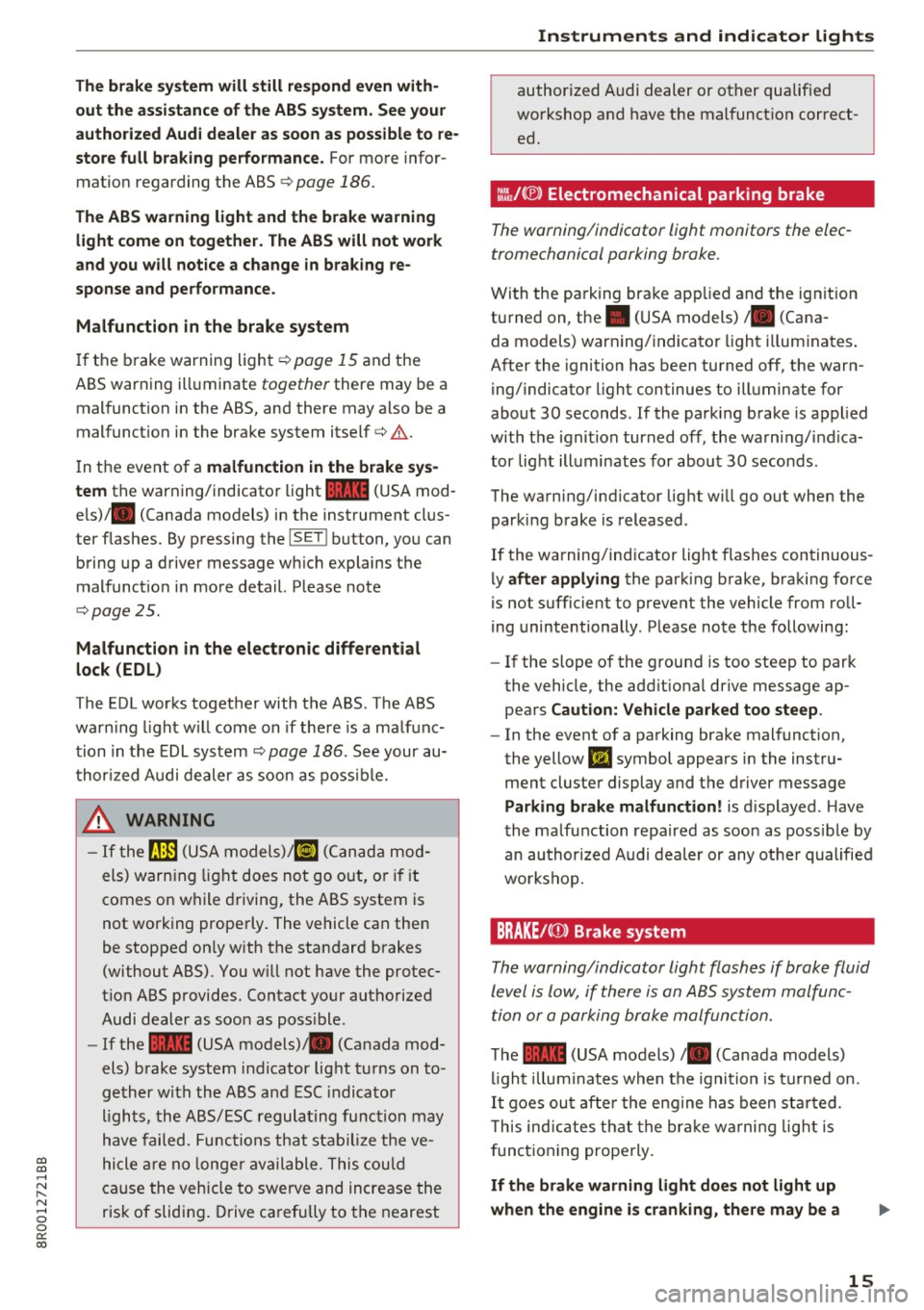
CD
CD
.... N ,-... N ..... 0 0 C<'. 00
The brake system will still respond even with
out the assi stance of the ABS system. See your
authorized Audi dealer as soon as possible to re
store full braking performance.
For more infor
mat ion regarding the ABS
¢ page 186.
The ABS warning light and the brake warning
light come on together. The ABS w ill not work
and you will not ice a change in braking re
sponse and performance.
Malfunction in the brake system
I f the b rake warning light¢ page 15 and the
ABS warning ill uminate
together there may be a
mal funct ion in the ABS, and there may also be a
malfunct ion in the brake system itself
c::> .&. .
In t he event of a malfunction in the brake sys
tem
the warning/indicator light 1111 (USA mod
e ls)/ . (Canada models) in the instrument clus
ter f lashes. By p ressing the
I SE TI button, you can
bring up a drive r message w hich explains t he
malfunct io n in more detail. Please no te
c::> page 2 5.
Malfunction in the electronic differential
lock (EDL)
The EDL works togethe r with the ABS . The ABS
war ning light w ill come on if there is a ma lf u nc
tion in the EDL sys tem
c::> page 186 . See your au
t hor ized Audi dealer as soon as poss ible.
.8, WARNING
- If t he 9 (U SA m odels)/ KO'A
comes on w hile driving, the ABS sy stem is
not wo rking prope rly . The vehicle can then
be stopped on ly with the standard brakes
(without ABS). You w ill not have the protec
t io n ABS p rovides . Contact yo ur aut horized
Audi dealer as soon as poss ible .
- If the
1111 (USA models) . (Canada mod
els) b rake system indicator light t urns on to
ge ther wi th the ABS a nd ESC indica to r
ligh ts, the ABS/ ESC regula ting func tion may
h ave failed. Func tions that s tabiliz e t he ve
hicle are no lo nger av ailable . Thi s co uld
c a use the vehicle to swe rve and in crea se the
risk of sliding . Drive c arefully to t he nearest
-
Instruments and ind icator lights
author ized Audi dealer or ot her qualif ied
wo rkshop and have t he mal funct ion correct
ed .
::~/(®) Electromechanical parking brake
The warning/indicator light monitors the elec
tromechanical parking brake.
Wi th the pa rking bra ke app lied and the ig nit io n
tu rned on , the . (USA models)/ . (Cana-
da models) warning/indicator light illum inates .
A fter the ignition has been turned off, t he warn
ing/indicato r light continues to ill uminate for
abo ut 30 seconds . If the parki ng brake is applied
with the igni tion turned off, the warn ing/ indica
tor light ill uminates for about 30 secon ds.
The wa rning/i ndicator lig ht wi ll go out when the
parking brake is released .
If the warning/ind icator light flashes continuous
ly
after applying the par king b rake, bra king force
is not sufficient to prevent the vehicle from roll
ing unintentionally . P lease note the following :
- If the slope of the grou nd is too steep to park
the vehicle, the add it iona l drive message ap
pea rs
Caution: Vehicle parked too steep .
-In the event o f a pa rking brake mal function,
the yellow
liJ symbol appears in the instru
ment cluste r display and the driver message
Parking brake malfunction! is d isplayed . Have
t he malfunction repaired as soon as poss ible by
an au thor ized A udi dealer or any ot her qualified
workshop.
BRAKE /(Q) ) Brake system
Th e warning/indicator light flashes if brak e fluid
level is lo w, if there is an AB S system malfunc
tion or a p arking brake malfun ctio n.
T he 1111 (USA models) /. (Canada models)
li gh t illu min ates when t he igni tio n i s tur ned on.
It goe s ou t af te r th e e ng ine h as been st arted.
T h is ind icates t hat t he br ake w arning light is
f unct ioning properly.
If the brake warning light doe s not light up
when the engine is cranking, there may be a
15
Page 18 of 296
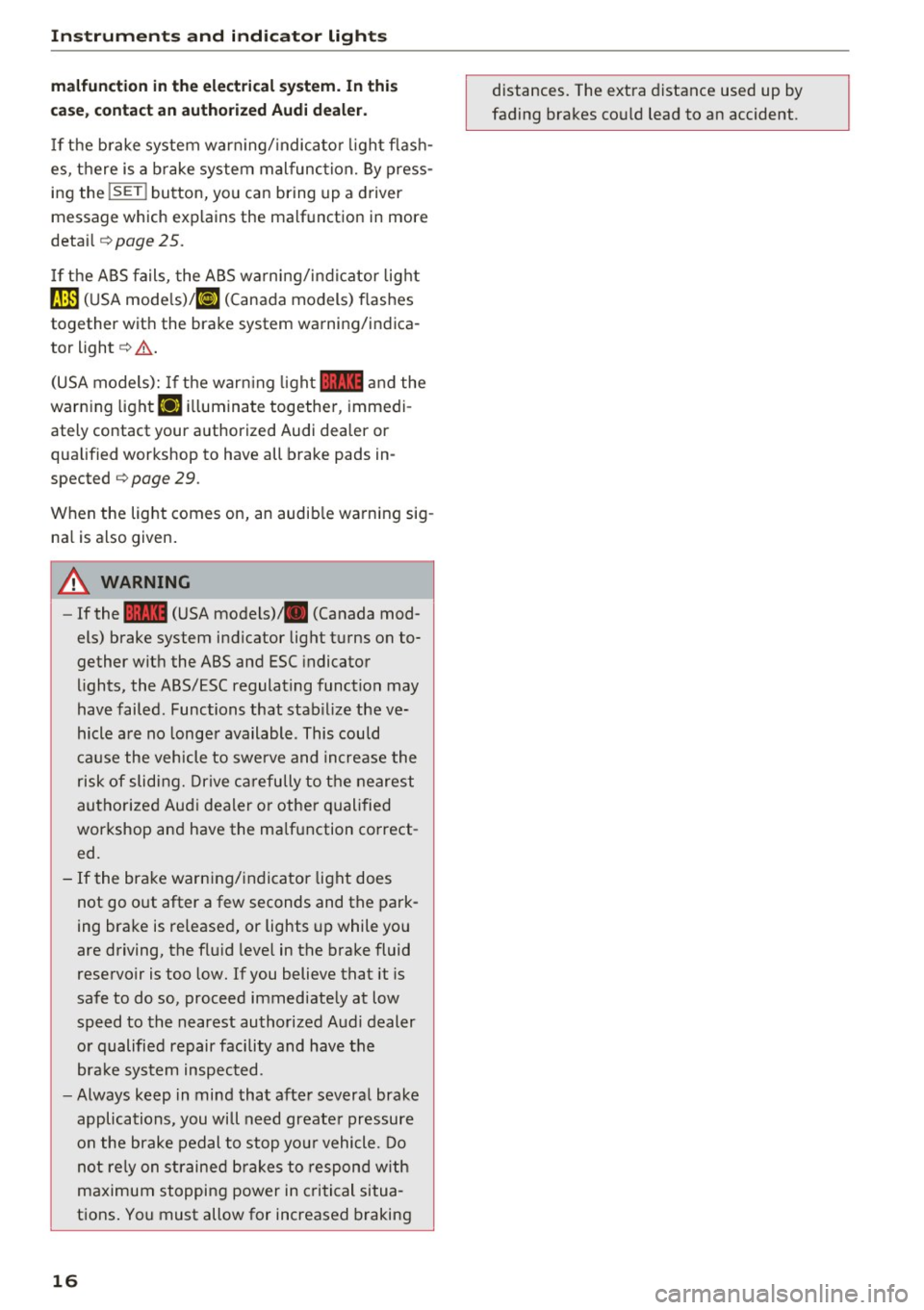
Instruments and indicator lights
malfunction in the el ectric al sy stem. In this
case , contact an autho rized Audi deale r.
If t he b rake system war ning/ indica to r li ght flash
es, there is a b rake system mal funct ion. By press
ing the
! SE T! button, you can bring up a driver
m essage which explains the malf unction in mor e
detai l
¢pag e 25.
If the ABS fails, the ABS warning/indicator light
~ ( U SA mode ls)/ (IJ (Canada models) flashes
together with the brake system warning/indica
tor light ¢& .
(USA models): If the warn ing light
1111 and the
warn ing light
Ii] ill uminate together , immedi
ately contact your authori zed Audi dea ler or
qualified workshop to have all brake pads in
spec ted
¢ page 29 .
When the light comes on, an audib le warning sig
na l is also given .
A WARNING
-If the 1111 (USA models) . (Canada mod
els) brake system indicator light t urns on to
gether with the ABS and ESC indicator
lights, the ABS/ESC regulating function may
have failed . Functions that stab ilize the ve
hicle a re no longe r available . This could
ca use the vehicle to swerve and increase the
risk of sliding. Drive ca refully to t he nearest
autho rize d Aud i dealer or other quali fied
workshop and have the ma lfunction co rrect
ed.
- If the bra ke warn ing/indicator light does
not go out after a few seconds and the park
ing brake is released, or lights up while you
are driving, the flu id leve l in the brake fluid
reservoir is too low. If you believe that it is
safe to do so, proceed immediately at low
speed to the nearest authorized Audi dealer
o r qualified repair facility and have the
bra ke system inspected.
- Always keep in mind tha t afte r severa l brake
applications, you will need greate r pressure
o n the brake pedal to stop yo ur vehicle. Do
not rely on straine d brakes to respond w ith
maximum stopping power in criti cal situa
tions . You must allow for increased braking
16
distances. The extra distance used up by
fading brakes co uld lead to an accident .
Page 28 of 296
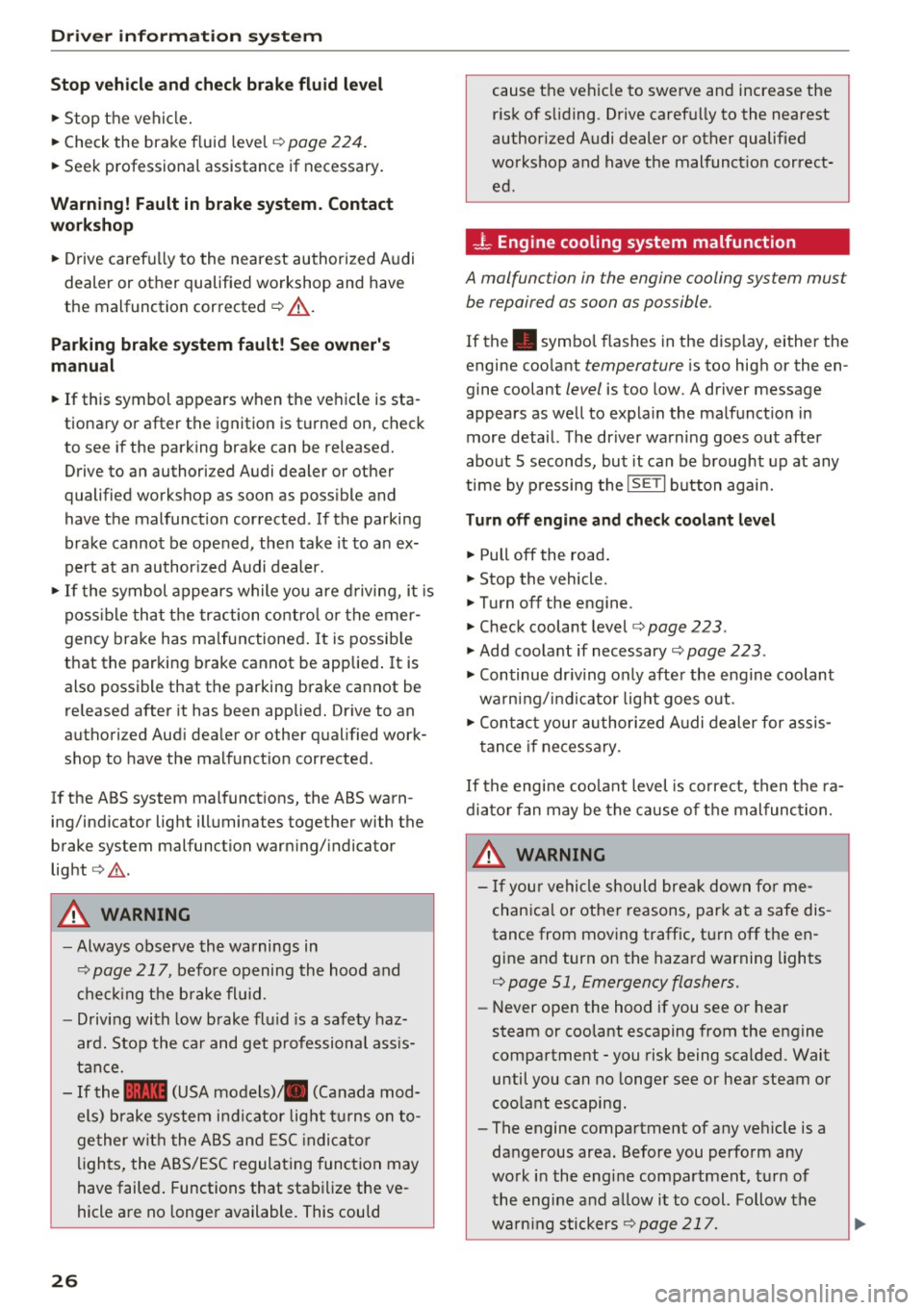
Driver information s ystem
Stop vehicle and check brake fluid level
.,. Stop the vehi cle.
.,. Check the brake f luid leve l¢
pag e 224 .
.,. Seek professional assistance if necessary.
Warning! Fault in brake system. Contact
work shop
.,. Drive carefu lly to the nearest authorized A udi
dealer or other qualified workshop and have
the malfunction corrected ¢
,&..
Parking brake system fault! See owner 's
manual
.,. If this symbol appears when the ve hicle is sta
tionary or after the ignition is turned on, check
to see if the park ing brake can be released.
Drive to an authori zed Audi dealer or other
qualified workshop as soon as poss ible and
have the malfunction corrected . If the parking
brake cannot be opened, then take it to an ex
pert at a n author ized Audi dealer.
.,. If the symbol appears while you are d riving, i t is
poss ible th at t he traction co ntro l or the emer
gency brake has malfunctioned . It is possib le
that the parking brake cannot be applied .
It is
also possible that th e parking brake cannot be
released after it has been applied. Drive to an
authori zed Aud i dea ler or other qualified work
shop to have the malfunct io n corrected.
If the ABS system malfunct ions, the ABS warn
ing/indicator light illuminates together with the
brake system malfunction warn ing/ indicator
light ¢.&. .
A WARNING
-Always observe the warnings in
¢page 217, before opening the hood and
c he ck ing the b rake fl uid .
- Driving with low brake fl uid is a safety haz
ar d. Stop the car and get professional ass is
tan ce.
- If the .. (USA models) . (Canada mod
els) brake system i ndic ator lig ht tu rns on to
ge ther wit h the ABS and ES C i ndi ca to r
ligh ts, the ABS/ ESC regula ting func tion may
have failed . Functions that stab ilize the ve
hicle a re no longe r available. This could
26
cause the vehicle to swerve and increase the
r isk of sliding. Drive caref ully to the nearest
author ized Audi dealer or other qualified
workshop and have the malfunct io n correct
ed.
- L Engine cooling system malfunction
A malfunction in the engine cooling system mu st
be repaired as soon as possible.
If the . symbol flashes in the disp lay, either the
engine coo lant
temperature is too high or the en
gine coolant
level is too low. A driver message
appears as we ll to expla in the malfunct ion in
more detail. The dr iver warn ing goes out after
about 5 seconds, but it can be b rought up at any
time by p ressing the
IS ET I button agai n.
Turn off engine and check coolant level
.,. Pull off the road .
.,. Stop the vehicle .
.,. Turn off the engine .
.,. Check coolant level¢
page 223 .
.,. Add coolant if necessary ~ page 223.
.,. Continue dr iv ing only after the engine coolant
wa rning/i nd ic ator light goes out .
.,. Contact your authori zed A udi dealer for assis
tance if ne cessa ry.
If the engine coo lant level is correct, then t he ra
diato r fan may be the cause of t he malfunc tion.
A WARNING ~
- If you r vehicle should break down fo r me-
chan ica l or othe r reasons, park at a safe dis
tance from mov ing traffic, turn off the en
gine and turn on the hazard warning lights
¢ page 51, Emergency flashers.
- Never open the hood if you see or hear
steam or coolant escaping from the engine
compartment -you risk being scalded. Wait
until you can no longer see or hear steam or
coo lant escaping .
- The engine compartment of any veh icle is a
dangerous area. Before you perfo rm any
work i n the engine compartment, turn of
t he engine and allow i t to cool. Follow the
warn ing stickers
¢ page 217. ~
Page 76 of 296
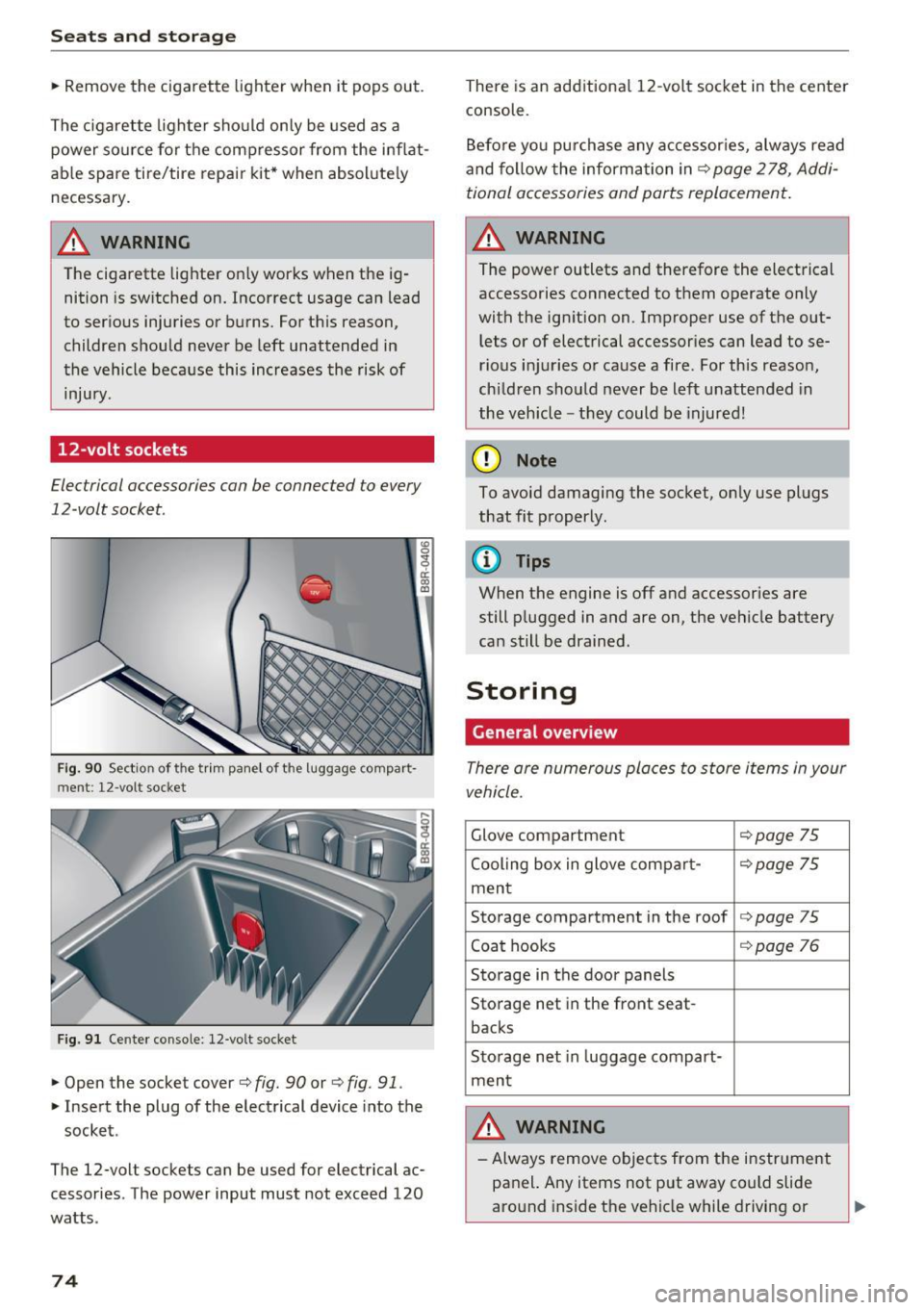
Sea ts and stor age
~ Remove the cigarette lighter when it pops out.
The cigarette lighter sho uld on ly be used as a
power so urce for the compressor from the inflat
ab le spare tire/tire repai r kit* when absol ute ly
necessary.
_& WARNING
-
T he cigarette lighter on ly works when the ig
nition is sw itched on. Incorrect usage can lead
to ser ious injuries or burns . For this reason,
children should never be left unattended in
the vehicle beca use this increases the risk of
injury.
12 -volt sockets
Electrical accessories can be connected to every
12-volt socket.
Fig. 90 Sect io n of the tr im pane l of the luggage compart
m ent: 12-volt soc ket
F ig. 9 1 Cente r console: 12-volt socket
~ Open the socket cover c:> fig. 90 or c:> fig. 91 .
"' 0
9 a: 00 m
~ Insert the plug of the electrical device into the
socket .
The 12-volt sockets can be used for electrical ac
cessories . The power input must not exceed 120
watts .
74
There is an additiona l 12-volt socket in the cente r
console.
Befo re yo u purchase any accessor ies, always read
and follow the information inc:>
page 2 78, Addi
tional accessories and parts replacement.
~ WARNING
The power outlets and therefore the electrical
accessories connected to them operate only
with the ign ition on. Improper use of the out
lets or of electrical accessor ies can lead to se
rious injuries o r cause a fire. Fo r this reason,
chi ldren should never be left unattended in
the vehicle -th ey could be injured!
(D Note
To avoid damaging the socket, only use plugs
that fit properly .
(!} Tips
When the engine is off and accessories are
still plugged in and are on, the vehicle battery
can still be drained.
Storing
General overview
There are numerous places to store i tems in your
vehicle.
Glove compartment c:> page 75
Cooling box in glove compa rt-¢ page 75
ment
Storage compartment in the roof
c:> page 75
Coat hooks c:>page 76
Storage in the door panels
Storage net in the front seat-
backs
Sto rage net in luggage compart-
men t
_& WARNING
- Always remove objects from t he i nstr ument
panel. Any items not put away could slide
around inside t he vehicle while driving or
~
Page 106 of 296
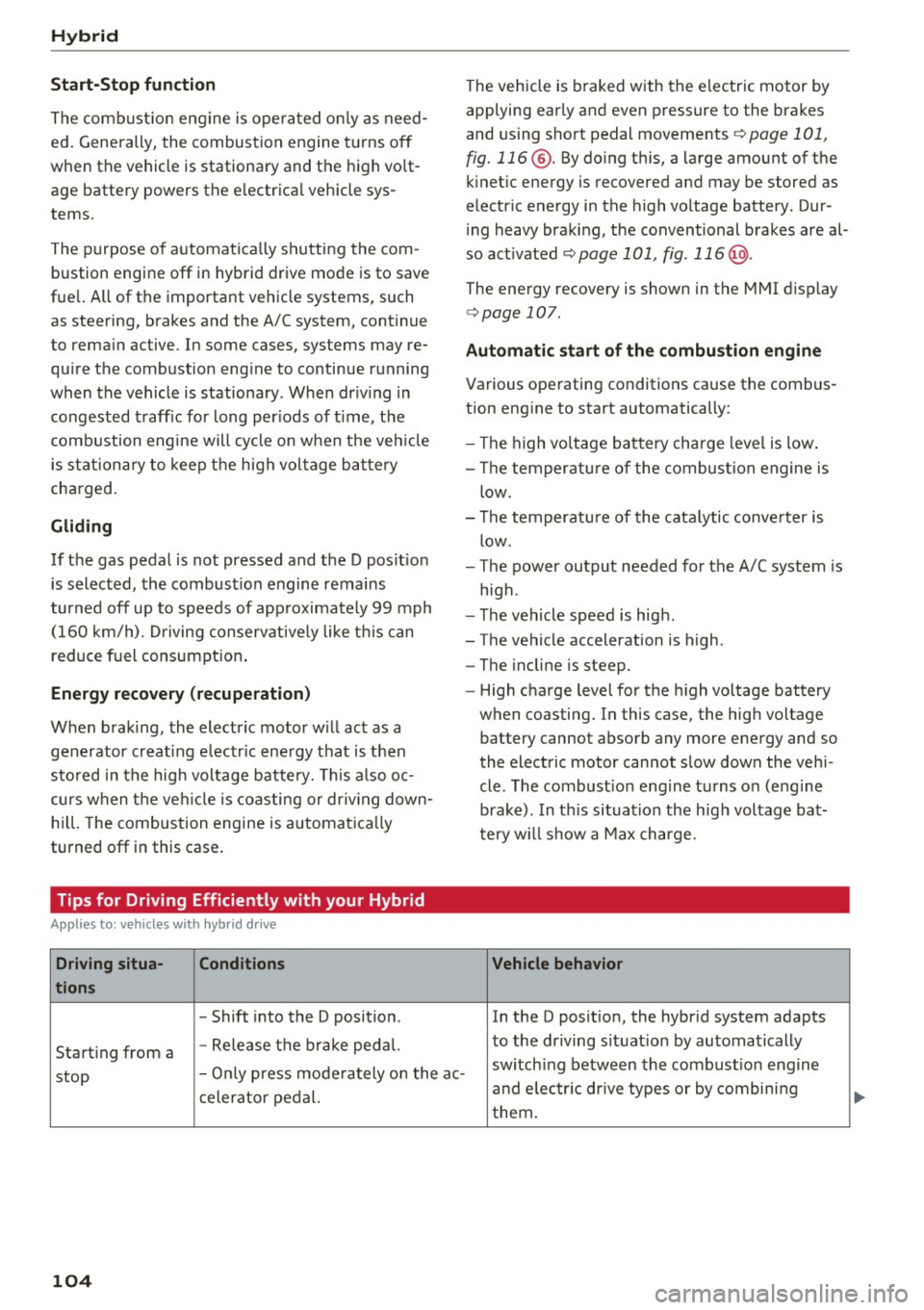
Hybrid
Start-Stop function
The combustion engine is operated on ly as need
ed . Generally, the combustion engine turns off
when the vehicle is stationary and the high volt
age battery powers the electrical vehicle sys
tems.
The purpose o f automatica lly shutting the com
bustion engine off in hybrid drive mode is to save
fuel. All of the important vehicle systems, such
as steering, brakes and the A/C system, continue
to remain active. In some cases , systems may re
qu ire the combustion eng ine to continue running
when the vehicle is stationary . When dr iv ing in
congested traff ic for long per iods of t ime, the
combustion eng ine will cycle on when the veh icle
is stationary to keep the high voltage battery
charged.
Gliding
If the gas pedal is not pressed and the D posit ion
is selected, the combustion engine remains
turned off up to speeds of approximately 99 mph
(160 km/h) . Driving conservative ly like th is can
reduce fuel con5umption .
Energy recovery (recuperation)
When braking, the electric motor will act as a
generator creating e lectr ic energy that is then
sto red in the high voltage battery. This also oc
curs when the vehicle is coasting or driving down
hi ll. The combustion engine is automat ica lly
turned off in this case .
Tips for Driving Efficiently with your Hybrid
Appl ies to: ve hicles w ith hyb rid drive
Driving situa- Conditions
tions
- Shift into the D position .
Starting from a -
Release the brake pedal. The vehicle is braked with
the electric motor by
applying early and even pressure to the brakes
and using short pedal movements
¢ page 101,
fig. 116 @. By doing this, a large amount of the
kinet ic energy is recovered and may be stored as
electric energy in the high voltage battery. Dur
i ng heavy brak ing , the conventional brakes are al
so act ivated
¢ page 101, fig . 116 @.
The energy recovery is shown in the MMI display
¢page 107 .
Automatic start of the combustion engine
Various operating conditions cause the combus
tion eng ine to start automatically:
- Th e high voltage battery charge level is low.
- Th e temperature of the combustion engine is
low .
- Th e temperature of the catalytic converter is
low .
- T he power output needed for the A/C system is
high.
- The vehicle speed is high .
- The vehicle acceleration is high .
- The incline is steep .
- High charge level for the high voltage battery
when coasting. In this case, the high voltage battery cannot absorb any more energy and so
the electric motor cannot slow down the veh i
cle. The combust ion engine turns o n (engine
brake) . In this situation the high voltage bat
t ery w ill show a Max charge.
Vehicle behavior
In the D posit ion, the hybrid system adapts
to the driving situat ion by automatically
stop -
Only press moderately on the ac- sw
itch ing between the combustion engine
and e lectr ic drive types or by combining
celerator pedal.
them.
104
...
Page 139 of 296
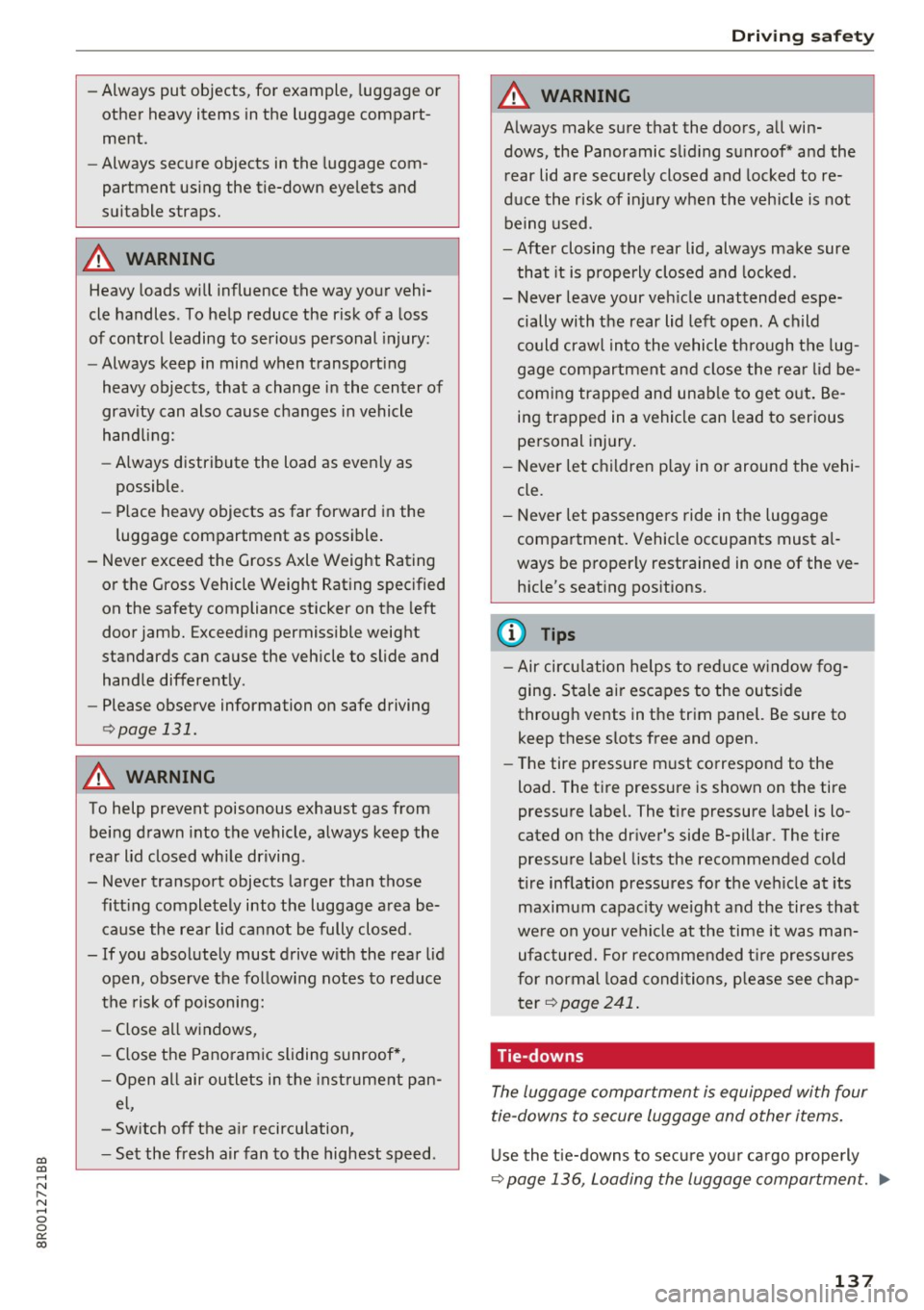
CD
CD
.... N ,-... N .... 0 0 C<'. 00
-Always put objects, for example, luggage or
other heavy items in the luggage compart
ment.
- Always secure objects in the luggage com
partment using the tie-down eyelets and
suitable straps.
A WARNING
Heavy loads will influence the way your vehi
cle handles . To help reduce the risk of a loss
of control leading to serious personal injury:
- Always keep in mind when transporting
heavy objects, that a change in the center of
gravity can also cause changes in vehicle
hand ling:
- Always distribute the load as evenly as
possible.
- Place heavy objects as far forward in the
luggage compartment as possible.
- Never exceed the Gross Axle Weight Rating
or the Gross Vehicle Weight Rating specified
on the safety compliance sticker on the left
door jamb. Exceeding permissible weight
standards can cause the vehicle to slide and
handle differently .
- Please observe information on safe driving
<=>page 131.
A WARNING
To help prevent poisonous exhaust gas from
being drawn into the vehicle, always keep the
rear lid closed while driving .
- Never transport objects larger than those
fitting completely into the luggage area be
cause the rear lid cannot be fully closed .
- If you absolutely must drive with the rear lid
open, observe the following notes to reduce
the risk of poisoning:
- Close all windows,
- Close the Pano ramic sliding sunroof*,
- Open all air outlets in the instrument pan-
el,
- Switch off the air recirculation,
- Set the fresh air fan to the highest speed .
Driving safety
A WARNING
-
Always make sure that the doors, all win
dows, the Panoramic sliding sunroof* and the
rear lid are securely closed and locked to re
duce the risk of injury when the vehicle is not
being used .
-After closing the rear lid, always make sure
that it is properly closed and locked.
- Never leave your vehicle unattended espe
cially with the rear lid left open. A child
could crawl into the vehicle through the lug
gage compartment and close the rear lid be
coming trapped and unable to get out. Be
ing trapped in a vehicle can lead to serious
personal injury.
- Never let children play in or around the vehi
cle.
- Never let passengers ride in the luggage
compartment. Vehicle occupants must al
ways be properly restrained in one of the ve
hicle's seating positions.
(D Tips
-Air circulation helps to reduce w indow fog
ging . Stale air escapes to the outside
through vents in the trim panel. Be sure to
keep these slots free and open.
- The tire pressure must correspond to the
load. The tire pressure is shown on the tire
pressure label. The tire pressure label is lo
cated on the driver's side B-pillar . The tire
pressure label lists the recommended cold
tire inflation pressures for the vehicle at its
maximum capac ity weight and the tires that
were on your vehicle at the time it was man
ufactured. For recommended t ire pressures
for normal load conditions, please see chap
ter
r=> page 241.
Tie-downs
The luggage compartment is equipped with four
tie-downs to secure luggage and other items.
Use the tie-downs to secure your cargo properly
Q page 136, Loading the luggage compartment . ..,_
137
Page 143 of 296
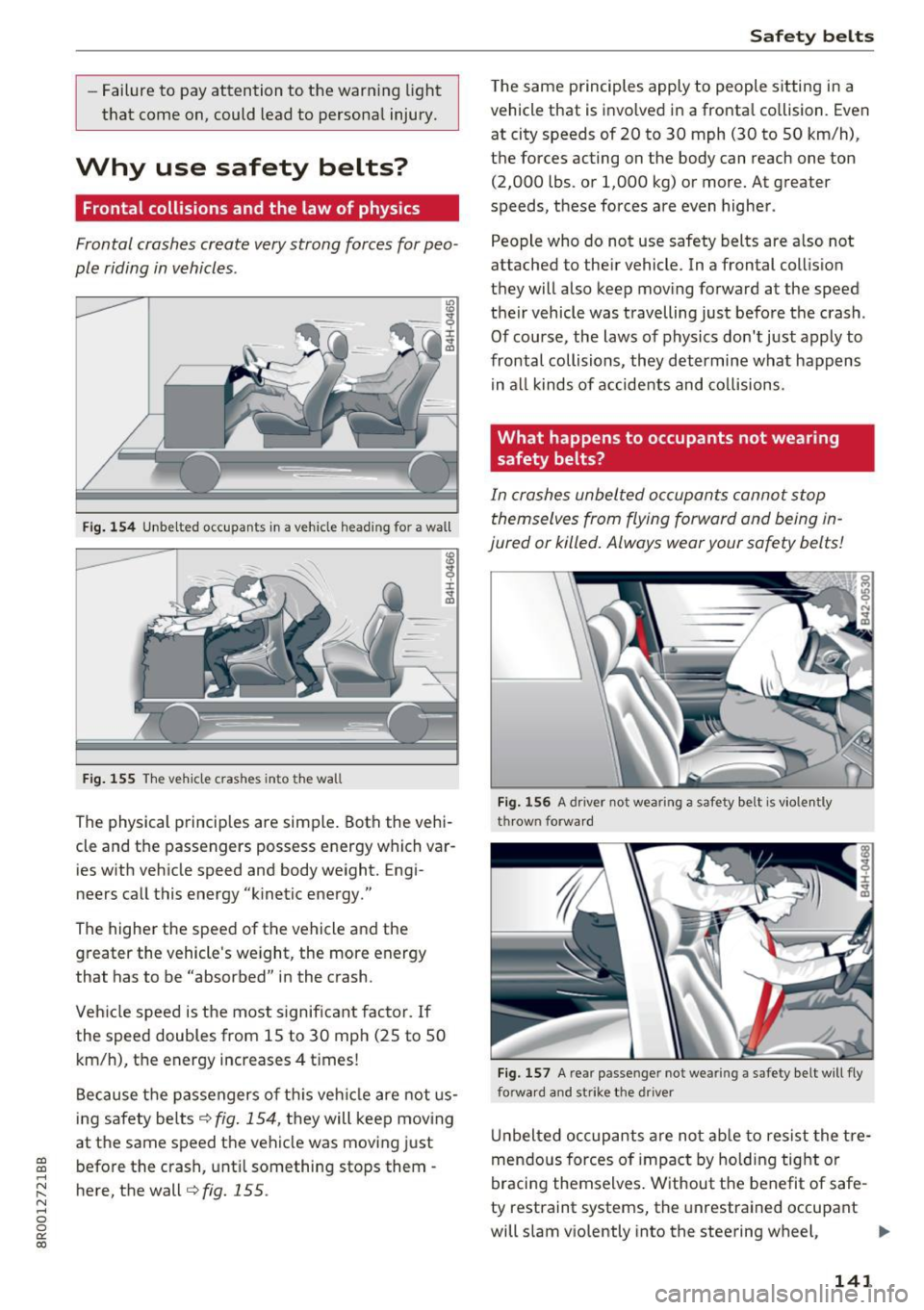
a,
a,
..... N r-N ..... 0 0
0:
co
-Failure to pay attention to the warn ing light
that come on, could lead to persona l injury.
Why use safety belts?
Frontal collisions and the law of physics
Frontal crashes create very strong forces for peo
ple riding in vehicles .
Fig. 154 Unbelted occupants in a vehicle heading for a wall
Fig. 155 The vehicle crashes into the wall
The physical principles are simple. Both the vehi
cle and the passengers possess energy which var ies with vehicle speed and body weight. Engi
neers call this energy "kinetic energy."
The higher the speed of the vehicle and the greater the vehicle's we ight, the more energy
that has to be "absorbed" in the crash.
Veh icle speed is the most significant factor. If
the speed doubles from 15 to 30 mph (25 to 50
km/h), the energy increases 4 t imes!
Because the passengers of this vehicle are not us
ing safety belts
¢fig. 154, they will keep moving
at the same speed the vehicle was moving just
before the crash, until something stops them -
here, the wall¢
fig. 155 .
Safety belts
The same p rinciples apply to people sitting in a
vehicle that is invo lved in a fronta l co llision. Even
at city speeds of 20 to 30 mph (30 to 50 km/h),
the forces acting on the body can reach one ton
(2,000 lbs. or 1,000 kg) or more. At greater
speeds, these forces are even higher.
People who do not use safety belts are a lso not
attached to the ir vehicle. In a frontal collis ion
they will also keep moving forward at the speed
their vehicle was travelling just before the crash .
Of course, the laws of physics don't just apply to
frontal collisions, they determine what happens in all kinds of accidents and collisions .
What happens to occupants not wea ring
safety belts?
In crashes unbelted occupants cannot stop
themselves from flying forward and being in
jured or killed. Always wear your safety belts!
Fig. 156 A dr iver not wearing a safety belt is violently
thrown forward
Fig . 157 A rear passe nger not wearing a safety belt will fly
forwa rd and strike the driver
Unbelted occupants are not able to resist the tre
mendous forces of impact by holding tight or
bracing themselves . Without the benefit of safe
ty restraint systems, the unrestrained occupant
will slam v iolently into the steering wheel,
Ill>-
141